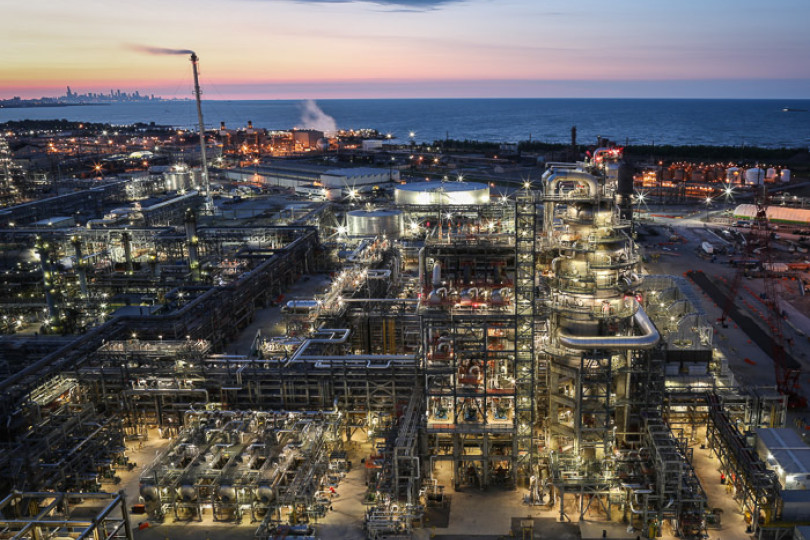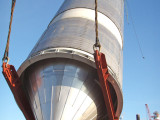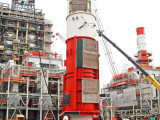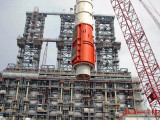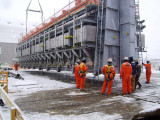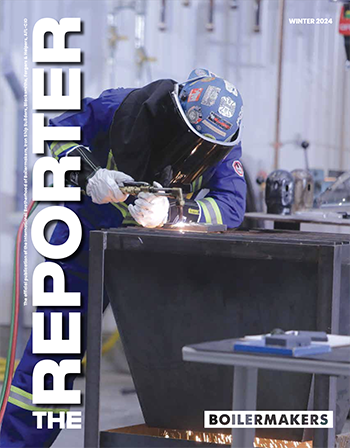No OSHA recordables, no lost-time injuries. It blows me away that with the magnitude of this job, it was so safe.
Evening shot of BP’s reconfigured 12 Pipestill unit. The new 166-ft.-tall vacuum tower is in the foreground.
Photo courtesy of BP.
View Photo Gallery (6 photos)
BP’s $4.2 billion private investment is largest in Indiana history
VIRTUALLY ALL OF the Boilermakers working the massive upgrade to the BP Whiting Refinery in northwest Indiana have gone home or moved on to other jobsites, but the skills they brought and the work they performed at the sprawling plant just south of Chicago will yield production improvements for years to come.
In mid-December 2013, BP announced that all major new units associated with the five-year, $4.2 billion modernization (the largest private investment in Indiana history) were successfully brought on stream. A month earlier, BP achieved start-up of the plant’s new 102,000 barrel-per-day, six-drum delayed coker — the second largest in the world — which transforms post-distillation residual oil into various petroleum products. The coker was the final big-ticket milestone to be achieved before full operations could begin.
The refinery upgrade will allow BP to process growing supplies of North American crude oil, including heavy crude from the Canadian oil sands region. And it will stand as a testament not only to superb planning, engineering, and coordination required but also to the skills of some 14,000 building trades workers from around the United States and Canada, including as many as 500 Boilermakers at peak employment.
(Boilermakers are also involved at the upstream end of the Canada-to-U.S. crude shipments. Thousands of members, primarily from Local 146 in Edmonton, Alberta, work in the province’s Athabasca oil sands to build and maintain the systems for extracting and pre-processing oil sands bitumen.)
“The biggest job we have ever done”
LOCAL 374, Hammond, Ind., helped coordinate the flow of Boilermakers into and out of the Whiting Refinery Modernization Project (WRMP), noted Dan McWhirter, the lodge’s business manager and secretary-treasurer. “It’s by far the biggest job we have ever done in this jurisdiction. Our local came together with the NTD (National Transient Division, the union’s tank builders) — and the Boilermakers and all the crafts gave a great accounting of themselves. BP is ecstatic about this project. To have brought all these workers together in one place and after all the years of work to have such a great safety record, it was an accomplishment you just don’t see very often.”
Work on the WRMP began in May 2008, and required more than 70 million man-hours by the trades to complete. Major engineering contractors overseeing the work included Fluor Constructors, Jacobs Engineering, and Foster Wheeler. The next tier of contractors and their primary work scopes included BMW Constructors, replacement and upgrade of distillation units; CTI, No. 12 Pipestill, gas oil hydrotreaters (GOHT), selective catalytic reduction (SCR) system, and vapor recovery unit (VRU 300); Graycor, naptha splitting unit, six-drum delayed coker unit 2, and coker material handling; and Nooter Construction, heaters, furnaces and work on the coker.
The project involved the installation of about 380 miles of pipe, 1,200 pieces of major equipment, 600 shop-fabricated modules, and 50,000 tons of steel.
“There were some difficult conditions here . . . having to work on a tight site and . . . in below-zero conditions and high winds,” said Greg Ivey, CTI operations manager and a third-generation Boilermaker. “I never heard anyone complain. The Boilermakers are some of the most talented and hard-working craftsmen you’re going to find in the country.” Ivey said CTI’s largest effort was installing the No. 12 Pipestill, the first destination for incoming crude. Completed in early 2013, the still strips out impurities and then fractions out the petroleum to other areas of the refinery.
Upgrade allows processing 80 percent heavy crude
RATED AT 413,000 barrels per day, Whiting is the sixth largest refinery in the United States. The facility, which began operating in 1889, is situated on 1,400 acres along Lake Michigan. It employs nearly 1,900 in-house workers.
The plant receives raw crude oil via pipeline and ships refined product, also by pipeline, throughout the Midwest. The current project will provide Whiting with the capability to process up to 80 percent heavy crude, versus about 20 percent before the upgrade. It will also meet BP’s goal of increasing the refinery’s capacity for gasoline and diesel production by about 15 percent, equivalent to about 1.7 million gallons, or 40,000 per day.
Iain Conn, chief executive of BP’s downstream segment, said the refinery was expected to ramp up the processing of progressively higher Canadian crude through the first quarter of 2014.
“The safe start-up of this world-scale coker is the last major step in unlocking the full potential of the Whiting Refinery for our shareholders,” he said. “The reconfigured refinery now has the flexibility to greatly increase heavy sour crude processing . . .”
Boilermakers meet manpower, safety demands
BOILERMAKER MANPOWER requirements were extensive, both for new construction and demolition work, according to BP Deputy Construction Manager Mike Berna.
“The Boilermakers have done an outstanding job.”
— Mike Berna, BP Deputy Construction Manager
“Boilermakers were involved in hundreds of critical lifts across all of the WRMP,” he said, “including the coker, GOHT, SRC, OSBL, and 12 Pipestill. They erected many vessels, then installed trays and associated platforms and handrails. Boilermakers were integral in the revamp success of the 12 Pipestill demolition, the outcome of the 12 Pipestill transitional outage, the revamp of VRU 300, the current SRU turnarounds, and the A/B/C Claus Train revamps.
“My sincere thanks to their entire workforce for their safe execution, upfront planning, and unwavering efforts to make WRMP a game changer for the BP One Whiting site. The Boilermakers have done an outstanding job.”
As manpower needs ramped up, Local 374 brought in members from across the country, drawing mainly from Local 1 (Chicago), Local 60 (Peoria, Ill.), and Local 40 (Elizabeth-town, Ky.), said Local 374 Business Agent Doug Arambula.
“The work at the refinery involved a lot of man-hours, a lot of coordination, and a lot of skilled people,” he said. “[BP] was a major employer for us for years, and we had additional challenges with manpower, because we had our usual steel mill and power plant work going on. We put out the call for manpower, and we were never short.”
Arambula noted that the trades typically worked 10-hour shifts during the project and that weld rejection rates were held to an impressive two percent.
“This project is a shining example of what owners, contractors, and union workers can achieve together.”
— IVP Larry McManamon
Greg Baron, a Local 374 member and project manager for Nooter Construction, called the project “amazing.” He added, “There were license plates . . . from all over the country, and the dynamics of managing the workforce with so much going on at the site was really something to see.”
CTI’s Ivey observed: “The quality of work was unparalleled, but what I am most proud of is with all the thousands of man-hours that were worked, it has been such a safe job. No OSHA recordables, no lost-time injuries. It blows me away that with the magnitude of this job, it was so safe. Everybody bought into the safety culture.”
Pat Stefancin, the Boilermakers International Rep for Local 374, said the long-term project and 10-hour shifts required commitment, dedication, and professionalism. “That’s what makes Boilermakers second to none. Boilermakers and their families make the necessary sacrifices to get it done right the first time.”
Larry McManamon, IVP-Great Lakes, summed up the project’s success this way: “It takes a tremendous combination of the right skills, the right attitude, and a devotion to safety to pull off a project of this scale and complexity. This project was superbly planned, engineered, and executed. Every Boilermaker and indeed every union tradesperson who played a role should be extremely proud. This project is a shining example of what owners, contractors, and union workers can achieve together.”

